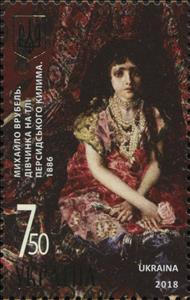Stamp: "Girl against the Background of Persian Carpet" (1886) (Ukraine 2018)
"Girl against the Background of Persian Carpet" (1886) (Ukraine 2018)
27 July (Ukraine ) within release The Art of Mikhailo Vrubel goes into circulation Stamp "Girl against the Background of Persian Carpet" (1886) face value 7.50 Ukrainian hryvnia
| Stamp "Girl against the Background of Persian Carpet" (1886) in catalogues | |
|---|---|
| Michel: | Mi: UA 1707 |
| WADP Numbering System - WNS: | WAD: UA033.18 |
Stamp is vertical format.
Stamp from souvenir sheet Mi:UA BL150Also in the issue The Art of Mikhailo Vrubel:
- Souvenir Sheet - The Art of Mikhailo Vrubel face value 20;
- Stamp - "Girl against the Background of Persian Carpet" (1886) face value 7.50;
- Stamp - "Angel with Censer and Candle" (1887) face value 7.50;
- Stamp - Self portrait face value 5;
Stamp "Girl against the Background of Persian Carpet" (1886) it reflects the thematic directions:
Art is a diverse range of human activities in creating visual, auditory or performing artifacts (artworks), expressing the author's imaginative or technical skill, intended to be appreciated for their beauty or emotional power. In their most general form these activities include the production of works of art, the criticism of art, the study of the history of art, and the aesthetic dissemination of art. The oldest documented forms of art are visual arts, which include creation of images or objects in fields including painting, sculpture, printmaking, photography, and other visual media. Architecture is often included as one of the visual arts; however, like the decorative arts, or advertising, it involves the creation of objects where the practical considerations of use are essential—in a way that they usually are not in a painting, for example. Music, theatre, film, dance, and other performing arts, as well as literature and other media such as interactive media, are included in a broader definition of art or the arts. Until the 17th century, art referred to any skill or mastery and was not differentiated from crafts or sciences. In modern usage after the 17th century, where aesthetic considerations are paramount, the fine arts are separated and distinguished from acquired skills in general, such as the decorative or applied arts.
Painting is the practice of applying paint, pigment, color or other medium to a solid surface (support base). The medium is commonly applied to the base with a brush, but other implements, such as knives, sponges, and airbrushes, can be used. Painting is a mode of creative expression, and the forms are numerous. Drawing, gesture (as in gestural painting), composition, narration (as in narrative art), or abstraction (as in abstract art), among other aesthetic modes, may serve to manifest the expressive and conceptual intention of the practitioner. Paintings can be naturalistic and representational (as in a still life or landscape painting), photographic, abstract, narrative, symbolistic (as in Symbolist art), emotive (as in Expressionism), or political in nature (as in Artivism). A portion of the history of painting in both Eastern and Western art is dominated by spiritual motifs and ideas. Examples of this kind of painting range from artwork depicting mythological figures on pottery, to Biblical scenes rendered on the interior walls and ceiling of the Sistine Chapel, to scenes from the life of Buddha or other images of Eastern religious origin. In art, the term painting describes both the act and the result of the action. The support for paintings includes such surfaces as walls, paper, canvas, wood, glass, lacquer, clay, leaf, copper and concrete, and the painting may incorporate multiple other materials including sand, clay, paper, plaster, gold leaf, as well as objects. The term painting is also used outside of art as a common trade among craftsmen and builders.


